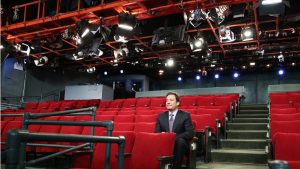Last week, Jimmy Fallon had an audience in his “Tonight Show” studio for the first time in a year. It wasn’t a full house, but at least he had a crowd to work to, as Bill Maher has had for a couple of months on “Real Time.”
In both cases, the positive impact of having humans react to their jokes in real time was clear on the hosts’ faces and in their delivery. Until recently, they only had sycophantic staff members standing around and overreacting to every punchline or applause break. Now, they have over-amped fans who fulfill the same role.
I expect the other late night hosts will start filling their audience seats soon, too. For all of them, it took quite a while to adapt to working without an audience, and some of them never found a groove that fit, especially combined with guests Zooming in from home.
It’s been different for the half-hour topical comedy hosts who aren’t as reliant on booking big-name (or any) guests.
John Oliver has been head and shoulders above the rest, because even when there were onlookers, his “Last Week Tonight” was always an uninterrupted monologue-from-a-desk that, frankly, never needed a studio audience. The same goes for Samantha Bee, whose “Full Frontal” was just as entertaining when she was recording in her backyard with her family acting as crew. Trevor Noah took a little longer, but eventually found an even better way to do “The Daily Show” (which should never have adopted “The Daily Social Distancing Show” as its temporary name) by adding extra takes and asides to a second camera and relying less on correspondents doing field work.
In all three of those cases, they’ve developed just the right rhythms for their jokes without the laugh breaks. Yet I’m sure the hosts can’t wait to perform in front of a roomful of strangers again, thinking — mistakenly, I believe — they need that interaction to perform better.
The same applies to game shows like “Wheel of Fortune,” “The Chase,” and “Jeopardy!” which have been able to continue to produce new episodes in empty studios (by the way, I’m in the midst of a two-week boycott of “Jeopardy!” because I refuse to watch any thing Dr. Oz appears on). So have many others — although I have no idea how “Let’s Make A Deal” and “The Price Is Right” are working it out, since I never watch those shows.
Here’s another factor to consider: putting a couple hundred people in the seats costs money. Obviously, you need a bigger facility than if you shot the show on a small set. But you also have to have staff to deal with the influx of all those humans — from ticket coordinators to ushers to security.
Yes, working without a crowd means not getting immediate feedback on whether your material works. But I speak from experience when I tell you that’s not a fatal problem. To the contrary, it’s a replica of the world I (and every other radio broadcaster) have lived in — talking into microphones without contemporaneous in-person reactions.

